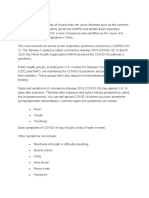Coronavirus: How Does The New Coronavirus Spread?
Coronavirus: How Does The New Coronavirus Spread?
Uploaded by
SAAVA WILLEX SALVATORECopyright:
Available Formats
Coronavirus: How Does The New Coronavirus Spread?
Coronavirus: How Does The New Coronavirus Spread?
Uploaded by
SAAVA WILLEX SALVATOREOriginal Description:
Original Title
Copyright
Available Formats
Share this document
Did you find this document useful?
Is this content inappropriate?
Copyright:
Available Formats
Coronavirus: How Does The New Coronavirus Spread?
Coronavirus: How Does The New Coronavirus Spread?
Uploaded by
SAAVA WILLEX SALVATORECopyright:
Available Formats
CORONAVIRUS
Lauren M. Sauer, M.S.
Coronaviruses are a type of virus. There are many different kinds, and some cause disease. A
newly identified coronavirus, SARS-CoV-2, has caused a worldwide pandemic of respiratory
illness, called COVID-19.
What You Need to Know
COVID-19
COVID-19 is the disease caused by the new coronavirus that emerged in China in
December 2019.
COVID-19 symptoms include cough, fever, shortness of breath, muscle aches, sore
throat, unexplained loss of taste or smell, diarrhea and headache. COVID-19 can be
severe, and some cases have caused death
The new coronavirus can be spread from person to person. It is diagnosed with a
laboratory test.
There is no coronavirus vaccine yet. Prevention involves frequent hand-washing,
coughing into the bend of your elbow, staying home when you are sick and wearing a
cloth face covering if you can't practice social distancing.
How does the new coronavirus spread?
As of now, researchers know that the new coronavirus is spread through droplets released into
the air when an infected person coughs or sneezes. The droplets generally do not travel more
than a few feet, and they fall to the ground (or onto surfaces) in a few seconds — this is why
social and physical distancing is effective in preventing the spread.
How did this new coronavirus spread to humans?
COVID-19 appeared in Wuhan, a city in China, in December 2019. Although health officials are
still tracing the exact source of this new coronavirus, early hypotheses thought it may be linked
to a seafood market in Wuhan, China. Some people who visited the market developed viral
pneumonia caused by the new coronavirus. A study that came out on Jan. 25, 2020, notes that the
individual with the first reported case became ill on Dec. 1, 2019, and had no link to the seafood
market. Investigations are ongoing as to how this virus originated and spread.
What is the incubation period for COVID-19?
It appears that symptoms are showing up in people within 14 days of exposure to the virus.
What are symptoms of COVID-19?
COVID-19 symptoms include:
Cough
Fever
Shortness of breath
Muscle aches
Sore throat
Unexplained loss of taste or smell
Diarrhea
Headache
In rare cases, COVID-19 can lead to severe respiratory problems, kidney failure or death.
If you have a fever or any kind of respiratory difficulty such as coughing or shortness of breath,
call your doctor or a health care provider and explain your symptoms over the phone before
going to the doctor’s office, urgent care facility or emergency room. Here are suggestions if you
feel sick and are concerned you might have COVID-19.
If you have a medical emergency such as severe shortness of breath, call 911 and let them know
about your symptoms.
Learn more about COVID-19 symptoms.
What Is Coronavirus?
How is COVID-19 diagnosed?
Diagnosis may be difficult with only a physical exam because mild cases of COVID-19 may
appear similar to the flu or a bad cold. A laboratory test can confirm the diagnosis. Learn more
about COVID-19 testing.
How is COVID-19 treated?
As of now, there is not a specific treatment for the virus. People who become sick from COVID-
19 should be treated with supportive measures: those that relieve symptoms. For severe cases,
there may be additional options for treatment, including research drugs and therapeutics.
Does COVID-19 cause death?
As of June 14, 2020, 430,542 deaths have been attributed to COVID-19. However, 3,721,731
people have recovered from the illness. This information comes from the Coronavirus COVID-
19 Global Cases map developed by the Johns Hopkins Center for Systems Science and
Engineering.
Is this coronavirus different from SARS?
SARS stands for severe acute respiratory syndrome. In 2003, an outbreak of SARS started in
China and spread to other countries before ending in 2004. The virus that causes COVID-19 is
similar to the one that caused the 2003 SARS outbreak: both are types of coronaviruses. Much is
still unknown, but COVID-19 seems to spread faster than the 2003 SARS and also may cause
less severe illness.
How do you protect yourself from this coronavirus?
It’s crucial to practice good hygiene, respiratory etiquette and social and physical distancing.
Read more about ways to protect yourself.
Coronavirus (COVID-19) Self-Checker
Check symptoms. Protect yourself. Get information.
Coronavirus: What do I do if I Feel Sick?
If you are concerned that you may have COVID-19, follow these steps to help protect your
health and the health of others.
About Coronaviruses
Coronaviruses are common in different animals. Rarely, an animal coronavirus can infect
humans.
There are many different kinds of coronaviruses. Some of them can cause colds or other
mild respiratory (nose, throat, lung) illnesses.
Other coronaviruses can cause more serious diseases, including severe acute respiratory
syndrome (SARS) and Middle East respiratory syndrome (MERS).
Coronaviruses are named for their appearance: Under the microscope, the viruses look
like they are covered with pointed structures that surround them like a corona, or crown.
Shared by Dr. Williams for medical awareness international
Credits to hopkinsmedicine.com
You might also like
- Coronavirus Assignment Info (To Summarize)Document12 pagesCoronavirus Assignment Info (To Summarize)iammateoguzman100% (1)
- Millions: Healthline'S Coronavirus CoverageDocument5 pagesMillions: Healthline'S Coronavirus CoverageSofiaNo ratings yet
- Coronavirus and COVID-19: What You Should Know: in This ArticleDocument4 pagesCoronavirus and COVID-19: What You Should Know: in This ArticleAB WPNo ratings yet
- Berlianda Jatiningrum Covid-19Document2 pagesBerlianda Jatiningrum Covid-19ZiggyNo ratings yet
- Report On COVID-19 Virus OutbreakDocument16 pagesReport On COVID-19 Virus OutbreakSara GuptaNo ratings yet
- Covid 19 Lumbika - Health AlertDocument12 pagesCovid 19 Lumbika - Health AlertAsus PCNo ratings yet
- Novel Coronavirus FactsheetDocument2 pagesNovel Coronavirus FactsheetSebastian LozanoNo ratings yet
- Introduction 1Document11 pagesIntroduction 1PARTHA PRATIM KARNo ratings yet
- Atividade de Inglês - 8º AnoDocument4 pagesAtividade de Inglês - 8º AnoGustavo HenriqueNo ratings yet
- COVID-19 Aka CoronavirusDocument4 pagesCOVID-19 Aka CoronavirusAzman Hossain OakingNo ratings yet
- CORONAVIRUS TEAM 4Document10 pagesCORONAVIRUS TEAM 4Wendy PerezNo ratings yet
- whatDocument1 pagewhatzballard147No ratings yet
- Reflection PaperDocument1 pageReflection PaperPcr DcpoNo ratings yet
- What Is Covid19Document7 pagesWhat Is Covid19Prity KumariNo ratings yet
- Report Text Covid-19Document1 pageReport Text Covid-19akayipengguriNo ratings yet
- Frequently Asked Questions: What Is COVID-19 (Coronavirus Disease 2019) ?Document4 pagesFrequently Asked Questions: What Is COVID-19 (Coronavirus Disease 2019) ?Jacques HammanNo ratings yet
- Coronavirus Covid - 19Document14 pagesCoronavirus Covid - 19Sohail KhanNo ratings yet
- What Is CoronavirusDocument11 pagesWhat Is CoronavirusYeasin ShezanNo ratings yet
- Central Public Sr. Sec. School: Summer Vacation Assignment Session 2021-2022 EnglishDocument9 pagesCentral Public Sr. Sec. School: Summer Vacation Assignment Session 2021-2022 EnglishGarvit Jain100% (1)
- Our New COVID-19 Vocabulary-What Does It All Mean - News - Yale MedicineDocument7 pagesOur New COVID-19 Vocabulary-What Does It All Mean - News - Yale Medicineantonia alves de oliveiraNo ratings yet
- Corona VirusDocument15 pagesCorona VirusRodolfo Esmejarda Laycano Jr.100% (2)
- The Coronavirus DiseaseDocument1 pageThe Coronavirus DiseaseMark BryanNo ratings yet
- MS Word Project Team GagnantsDocument11 pagesMS Word Project Team Gagnantsvijay chatterjeeNo ratings yet
- CovidDocument13 pagesCovidkashvi mittalNo ratings yet
- Assignment VirusDocument11 pagesAssignment VirusChristy Mutia AlumbroNo ratings yet
- COVID1Document3 pagesCOVID1Dez TabiosNo ratings yet
- Mrs - PradnyaJadhav (SSKJCN)Document15 pagesMrs - PradnyaJadhav (SSKJCN)pia espanillo100% (1)
- Thèmecovid 19Document4 pagesThèmecovid 19Fred MomboNo ratings yet
- Airborne Diseases PDFDocument5 pagesAirborne Diseases PDFZegera MgendiNo ratings yet
- Airborne Diseases PDFDocument5 pagesAirborne Diseases PDFZegera MgendiNo ratings yet
- All About Covid: Submitted By: Sophia Carmina V. SalardaDocument12 pagesAll About Covid: Submitted By: Sophia Carmina V. SalardaDahlia VillarNo ratings yet
- Nama: Azka Lutfiah NIM: 2030502135 MK: Bahasa Inggris Kelas: BPI 2052 EDocument6 pagesNama: Azka Lutfiah NIM: 2030502135 MK: Bahasa Inggris Kelas: BPI 2052 EFani DestianNo ratings yet
- Impact of Covid 19 On EnvironmentDocument20 pagesImpact of Covid 19 On EnvironmentRamkishan JaiswarNo ratings yet
- What Is A CoronavirusDocument3 pagesWhat Is A CoronavirusQuran Recitation and LessonsNo ratings yet
- Coronavirus : Surviving Covid-19 and Future Pandemics: Surviving Covid-19 and Future PandemicsFrom EverandCoronavirus : Surviving Covid-19 and Future Pandemics: Surviving Covid-19 and Future PandemicsNo ratings yet
- COVID-19: How Does This Virus Spread All Over The World ?Document5 pagesCOVID-19: How Does This Virus Spread All Over The World ?Indi GustiNo ratings yet
- Covid 19Document9 pagesCovid 19k.agnes12No ratings yet
- E TechDocument3 pagesE TechRobin Andrei PedrajaNo ratings yet
- WPS OfficeDocument5 pagesWPS Officeadenabas18No ratings yet
- COVID19Document1 pageCOVID19AUSTRIA, MA. MABEL S.No ratings yet
- Corona Virus PPT KrishDocument13 pagesCorona Virus PPT KrishkrishchannavipsNo ratings yet
- Coronavirus, COVID-19: A P P o I N T M e N T SDocument11 pagesCoronavirus, COVID-19: A P P o I N T M e N T SJi AhNo ratings yet
- Cover Pages of Projects... ANSHIKADocument22 pagesCover Pages of Projects... ANSHIKADr. Priyanka SinghNo ratings yet
- Impact of Covid-19Document20 pagesImpact of Covid-19iloli isaacNo ratings yet
- Description Covid-19Document3 pagesDescription Covid-19Keiren DesuNo ratings yet
- Covid How It SpreadsDocument7 pagesCovid How It Spreadshassankhan14345666No ratings yet
- What Is Novel CoronavirusDocument4 pagesWhat Is Novel CoronavirusJan Mae EstaresNo ratings yet
- Coronavirus Disease (Covid-19) Pandemic: Disusun Oleh: Nova Kamilia (1908026)Document4 pagesCoronavirus Disease (Covid-19) Pandemic: Disusun Oleh: Nova Kamilia (1908026)Slfwln ArmNo ratings yet
- Position Paper (EAPP)Document1 pagePosition Paper (EAPP)s.aszbinasNo ratings yet
- Coronavirus Outbreak: How to Stay Safe and What They Do Not Want You to Know About COVID-19?From EverandCoronavirus Outbreak: How to Stay Safe and What They Do Not Want You to Know About COVID-19?Rating: 1 out of 5 stars1/5 (1)
- Introduction To COVIDDocument7 pagesIntroduction To COVIDqaseem2109No ratings yet
- The Coronavirus Pandemic: Essential Guide to Understand & Protect Yourself from COVID-19From EverandThe Coronavirus Pandemic: Essential Guide to Understand & Protect Yourself from COVID-19No ratings yet
- Coronavirus COVIDDocument13 pagesCoronavirus COVIDCatherine AteradoNo ratings yet
- COVID-19 PresentationDocument25 pagesCOVID-19 PresentationGiorgi KenkebashviliNo ratings yet
- Covid - 19 Q&A EnglishDocument15 pagesCovid - 19 Q&A EnglishGIAN THE MOTANo ratings yet
- COVID-19: The True Meaning of "COVID-19" China Outbreak Virus in December 19Document2 pagesCOVID-19: The True Meaning of "COVID-19" China Outbreak Virus in December 19IrfanMajeedShahJillani100% (1)
- Kliping SerlyDocument11 pagesKliping SerlyYessi ApriyaniNo ratings yet
- Corona PDFDocument2 pagesCorona PDFIrfanMajeedShahJillani100% (1)
- Covid-19: Global Health IssueDocument4 pagesCovid-19: Global Health IssueAshim Chaudhary100% (1)
- Faqs - Covid-19 - 10032020Document5 pagesFaqs - Covid-19 - 10032020SizweNo ratings yet
- Gene Tech - Set 1 A2 Biology: by Akram SirDocument17 pagesGene Tech - Set 1 A2 Biology: by Akram SirMuhammad AkramNo ratings yet
- Admit CardDocument2 pagesAdmit CardRaghav WadhwaNo ratings yet
- Effictiveness of Eucalyptus Oil As Mosquito RepellentDocument1 pageEffictiveness of Eucalyptus Oil As Mosquito RepellentSHEAN GAYLE ANGNo ratings yet
- Covid Reference 04Document376 pagesCovid Reference 04lilik hunainahNo ratings yet
- Stitching Torlence and Washboard EffectDocument10 pagesStitching Torlence and Washboard EffectGovinda RajuluNo ratings yet
- Mod 6 - Micro To paraDocument18 pagesMod 6 - Micro To paraDonzzkie DonNo ratings yet
- Department of Molecular Biology. Covid 19 Test Name Result Unit Bio. Ref. Range MethodDocument4 pagesDepartment of Molecular Biology. Covid 19 Test Name Result Unit Bio. Ref. Range MethodGST WEST COMMISSIONERATENo ratings yet
- CBU School of Medicine MBS 240 (Laboratory Science) Term-1: Multiple Choice Questions (20 Marks)Document9 pagesCBU School of Medicine MBS 240 (Laboratory Science) Term-1: Multiple Choice Questions (20 Marks)lucky mbaselaNo ratings yet
- Pathophysiology of MeningitisDocument4 pagesPathophysiology of MeningitisDaryl BalangueNo ratings yet
- Endodontic Microbiology: Review of Literature: January 2011Document14 pagesEndodontic Microbiology: Review of Literature: January 2011Muhammad RaihanNo ratings yet
- Guidelines For Microbiology Teaching Laboratories: Revision 05.2018Document44 pagesGuidelines For Microbiology Teaching Laboratories: Revision 05.2018Nanik AndianiNo ratings yet
- Bacte MnemonicsDocument10 pagesBacte MnemonicsIan Leo SantosNo ratings yet
- Genetic Engineering Answer Key B5a61 6163ece5Document2 pagesGenetic Engineering Answer Key B5a61 6163ece5Cassandra CostunaNo ratings yet
- Amofah, 2019Document96 pagesAmofah, 2019Baseyem francisNo ratings yet
- C 8Document11 pagesC 8Tammie Gore100% (5)
- Wuchereria BancroftiDocument6 pagesWuchereria BancroftiAinur RohmahNo ratings yet
- Viruses in Marine EcosystemsDocument38 pagesViruses in Marine EcosystemsBarakNo ratings yet
- Epidemic and Pandemic WebquestDocument3 pagesEpidemic and Pandemic WebquestGlory RajiNo ratings yet
- Pyostacine SPC (2012)Document14 pagesPyostacine SPC (2012)Erick CoNo ratings yet
- Unit 4.1-4.3 NotesDocument62 pagesUnit 4.1-4.3 NotesJanice Loh (Lovely Janice)No ratings yet
- BioterrorismDocument26 pagesBioterrorismotherswork.000100% (1)
- Hyperlipidemia e Chart - Full IllustratedDocument13 pagesHyperlipidemia e Chart - Full IllustratedSanté QuantiqueNo ratings yet
- NKOM Self Declaration Form Rev-07Document1 pageNKOM Self Declaration Form Rev-07Adrian Cantaragiu100% (1)
- FLC Regions-WPS OfficeDocument3 pagesFLC Regions-WPS OfficePrecious BalgunaNo ratings yet
- Matthews 1998Document8 pagesMatthews 1998Yerly Ramirez MuñozNo ratings yet
- Understanding Blood Tests PDFDocument2 pagesUnderstanding Blood Tests PDFKishor SinghNo ratings yet
- Veterinary Vaccines and Diagnostics by W.jean Dodds, Ronald.D.schultzDocument875 pagesVeterinary Vaccines and Diagnostics by W.jean Dodds, Ronald.D.schultzKian TakallouNo ratings yet
- The Pathogenesis of Foot-and-Mouth Disease II ViraDocument23 pagesThe Pathogenesis of Foot-and-Mouth Disease II ViraJosé Arturo Bueno PérezNo ratings yet
- BIOL4411: Plant & Food BiotechnologyDocument68 pagesBIOL4411: Plant & Food BiotechnologyTing Yan LeeNo ratings yet
- Laboratory Investigation ReportDocument1 pageLaboratory Investigation ReportMd blackNo ratings yet

























































































